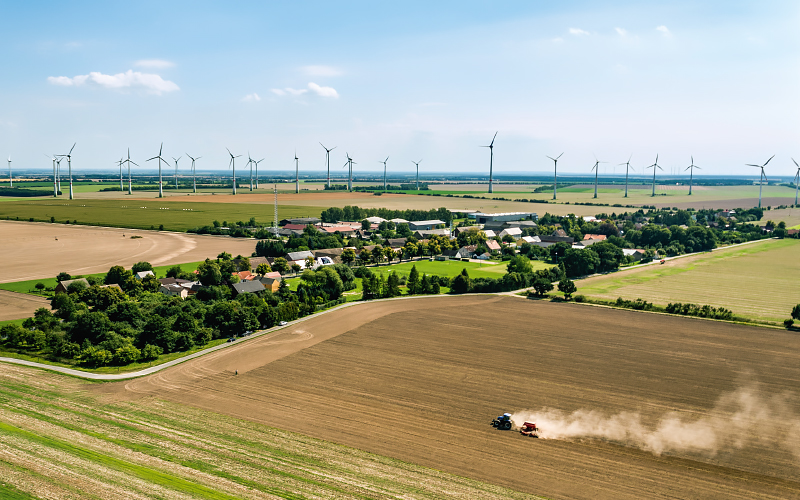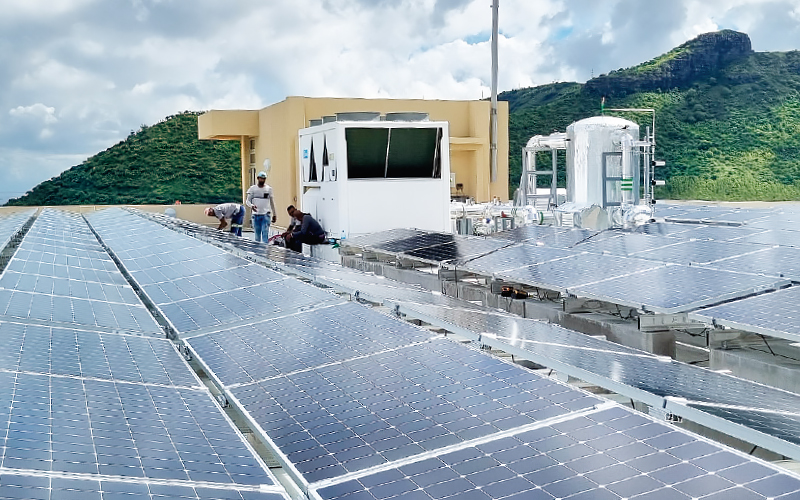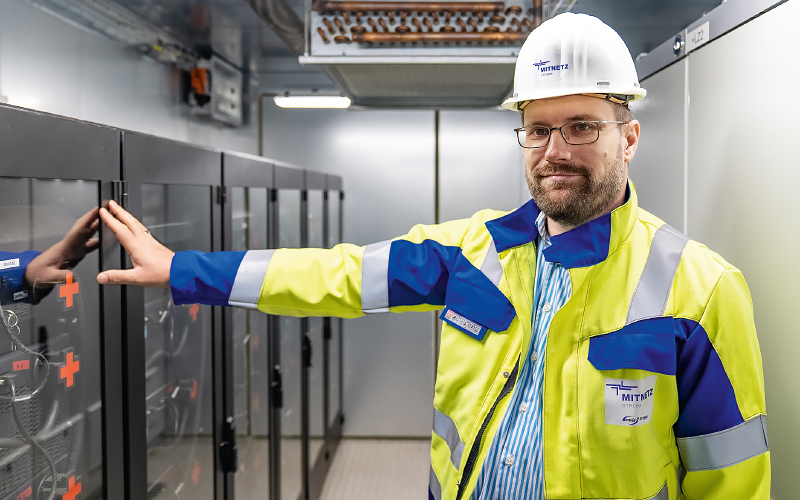The distribution networks were planned as one-way streets. Now there is a threat of heavy two-way traffic. Self-sufficient or decoupled grids are one way to relieve the upstream grids.
Stand-alone or “island” grids, self-sufficient local grids, decoupled low-voltage grids—these are buzzwords that are being heard more and more frequently in connection with the energy transition. The idea is that as more and more generation capacity migrates to local grids, they should become increasingly independent of upstream grids. The advantages: On the one hand, these “self-sufficient” local grids would no longer be affected by the uncertainties and voltage fluctuations of the upstream grids. And on the other hand, they themselves would no longer place such a heavy burden on the upstream networks from fluctuating feed-in, since distribution grids are still designed for electricity that only flows in one direction.
What sounds simple in theory, however, turns out to be a technically highly demanding undertaking in practice. However, a number of projects are showing how supply can succeed at the municipal level, whether through completely self-sufficient systems (Feldheim), isolated solutions (Mauritius) or a decoupled local grid (Niederbobritzsch). The common denominators in these solutions are modern converter systems and batteries for storage.
Feldheim: An energy-self-sufficient village
One of the showcase projects when it comes to energy self-sufficient communities is the Feldheim village of the Brandenburg town of Treuenbrietzen. Here, the German project developer Energiequelle has implemented one of the most ambitious overall concepts for a decentralized, regenerative energy supply for companies, private households and municipalities over the past 20 years.

The individually connected households here are supplied with electricity and heat autonomously via their own distribution network. All energy is generated on site exclusively from renewable sources. A wind farm is the basis for the local power supply; heat is supplied by a biogas plant. And if it gets particularly cold in winter, a woodchip heating plant is also available. The special feature of this energy concept is that the heat and electricity generated on site are fed directly to consumers and any surplus is fed into the upstream grid. Fluctuations in the grid are prevented by a regional regulating power plant and a battery storage system. As Doreen Raschemann from project developer Energiequelle told Deutschlandfunk radio: “The storage systems ensure that we really do have a stable grid, and that the frequency of 50 Hz is maintained.”
A TRUE “ISLAND” GRID FOR MAURITIUS
Tom Fricke and his team are active in many different parts of the world. He is Head of Energy Storage at DHYBRID, a solution provider for renewable energies and battery storage systems. Based in Gauting, Bavaria, the company designs hybrid systems worldwide that intelligently combine battery storage and renewable energies. For this purpose, DHYBRID supplies its own developed control solution as well as turnkey battery storage systems, thus shaping the future of energy systems, especially in South America, Africa and Asia.

Only recently, the specialists set up a stand-alone grid on Mauritius. There, the local energy supplier CEB prohibits photovoltaic systems from being connected directly to the grid. Fricke reports: “For cost and sustainability reasons, our customer Kalachand wanted to move away from diesel generators and the unstable power grid and cover its needs primarily with solar power. From a purely legal point of view, however, this was only possible if we physically decoupled the local grid from the upstream power grid and set up an independent island grid.” That’s because the sun shines on Mauritius for 2,900 hours a year. And during midday, the plant produces up to 535 kW. In order to save the energy into the night hours, the specialists from Dhybrid built a battery storage system with around 613 kWh and combined it with two Reinhausen GRIDCON® PCS converters, which set up an island grid that is physically separated from the public grid. Now the operator saves almost 214,000 liters of diesel per year and no longer has any power outages, which means that the entire system will pay for itself in just under four years. The advantage of this solution is that, as a pure consumer, it can still access the electricity in the upstream grid if necessary.
“Scenarios of severe voltage fluctuations and power outages lasting from seconds to more than 72 hours are no longer unthinkable.”
Tom Fricke, DHYBRID
The requirements are similar for other projects spread around the world. Fricke explains: “Many of our customers want to support their diesel or gas generators with renewables and thus reduce costs and consumption. For others, the issue is reliability, because either the upstream grid is unstable or they operate safety-critical applications that don’t tolerate downtime.” Looking at Germany and the European networks, Fricke makes interesting observations, “Here we’ve always had incredibly stable networks.” For this reason, this market was not very profitable for Dhybrid. “But in the meantime,” Fricke says, “the situation has changed and there is a rethinking in industry and politics. Scenarios of severe voltage fluctuations and power outages lasting from seconds to more than 72 hours are no longer unthinkable. Our solution portfolio can help bridge these disruptions sustainably.”
Niederbobritzsch makes it!
FlexNet-EkO — making network operation more flexible by means of decoupled local networks — is also concerned with the issue of supply quality and reliability of the local network. As part of this research project funded by the German Federal Ministry of Economics and Climate Protection (BMWK), the distribution network operator MITNETZ STROM has set up a local network in Niederbobritzsch whose only connection to the upstream network is via a power-electronic network coupling from Reinhausen (see ONLOAD 10).
“The system builds up a completely stable grid; interruptions are compensated for by the battery.”
Jens Schwedler, MITNETZ STROM
Project manager at MITNETZ STROM, the largest regional distribution system operator in eastern Germany, is Jens Schwedler. The question he has been working on for almost three years together with Mittweida University of Applied Sciences, Dresden Technical University and Reinhausen as a technology partner: How can a modular distribution network with a power-electronic grid coupling be constructed? To this end, the participants have been researching a system technology basis for the use of power electronic network couplings (eNCs). The basis is the decentralized and customer-oriented provision of the required voltage quality. In addition, the aim is to achieve simple and cost-effective regulation of controllable consumers, generators and storage units in the distribution network.
Highest voltage quality
Since September 2021, as part of a technical feasibility study, a gray container has been the heart of the distribution network in this Central Saxon municipality. It contains the storage units and a power-electronic grid coupling with a grid-forming converter. Schwedler reports: “The system has been running smoothly for four months. One positive aspect is that we are measuring excellent voltage quality which we could never have gotten from the public grid. The system simply filters out asymmetries from the medium-voltage grid and builds up a completely stable low-voltage grid. Interruptions are seamlessly compensated for by the battery.”

The control system developed byReinhausen is also impressive. It communicates via the power grid with signals in the 100 millihertz range. MITNETZ STROM was able to win several customers for a field test who have equipped inert loads such as wallboxes for e‑cars or heat pumps with a control box. If the power production falls below a critical value or is currently running on battery power due to an interruption, the charging process or the heat pump simply stops for this period. The customer is not even aware of this. Schwedler emphasizes: “This is about control technology for stabilizing the networks. For communication, I need a secure path. The results show that this can be frequency.”
Reinhausen technology has thus proven itself in Niederbobritzsch, making decoupling, grid building, storage and control all possible. In Schwedler’s view, the system thus has the potential to establish itself as the operating resource of the future: “The next question is whether the system can also assert itself economically against competing systems.” But here, too, the energy expert is optimistic.
YOUR CONTACT
 Do you have questions about the project?
Do you have questions about the project?
Stephan Rupp is there for you:
S.Rupp@reinhausen.com
